历史
The University of Waterloo was originally conceived in 1955 as the Waterloo College Associate Faculties (WCAF), a semi-autonomous entity within Waterloo College (now Wilfrid Laurier University, formerly known as Waterloo Lutheran University). The non-denominational school was founded in 1957 by Drs. Gerry Hagey and Ira G. Needles in Waterloo, Ontario. The Waterloo College of Arts became affiliated with the University of Western Ontario in 1925.
A plaque was erected just inside the entrance to the university on University Avenue West across from Seagram Drive, Waterloo:
| “ |
The University of Waterloo
In 1956 community leaders, headed by Dr. J. Gerald Hagey, formed the Waterloo College Associate Faculties, a non-denominational corporation, to provide Waterloo with improved educational facilities, particularly in the technical, scientific and engineering fields. A year later about seventy students, attracted by a pioneer programme in co-operative education, attended the institutions first classes. Full university powers were conferred by a 1959 Act and the next year the University awarded its first degrees. St. Jerome's College, a century-old Roman Catholic educational institution, federated with the University of Waterloo in 1960 and within the next year Renison (Anglican), St. Paul's (United Church) and Conrad Grebel (Mennonite) became affiliate colleges of the University.
|
” |
Today Wilfrid Laurier University is reputed for its liberal arts programs and the University of Waterloo is reputed for its engineering and math programs. The university's first president, Gerry Hagey, gathered teachers of engineering and basic sciences, and also obtained an initial grant of $625,000 from the government. The first 74 students began classes on July 1, 1957, in makeshift temporary buildings on the Waterloo College campus. In 1958, the University of Waterloo established an extension department.
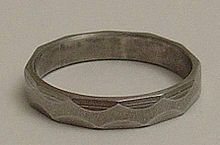
Iron Ring received by Engineering students at the University of Waterloo
In January 1958, Hagey and colleagues purchased 74 hectares (184 acres) of farmland a kilometre west of Waterloo College's main campus in order to meet the growing expansion needs. Soon, construction began of the first academic building on the new site, known as the Chemistry and Chemical Engineering Building, later renamed Engineering 1 and now named after Douglas Wright, UW's first Dean of Engineering. Through a series of delicate negotiations which turned into bitter hostilities, the "Faculty of Science and Engineering" broke free from Waterloo College, partly due to the fact that the two campuses were now disjoint. Hagey himself was opposed to the break, as his dream had been to establish a world-class university built on the strengths of Waterloo College's liberal arts strengths and the applied science education of WCAF.
The University of Waterloo in Waterloo, Ontario was incorporated and granted a university charter in 1959. In early 1959, the government established three universities: Waterloo Lutheran University, University of St. Jerome's College, and the University of Waterloo.
The policy of university education initiated in the 1960s responded to population pressure and the belief that higher education was a key to social justice and economic productivity for individuals and for society. The governance was modelled on the provincial University of Toronto Act of 1906 which established a bicameral system of university government consisting of a senate (faculty), responsible for academic policy, and a board of governors (citizens) exercising exclusive control over financial policy and having formal authority in all other matters. The president, appointed by the board, was to provide a link between the 2 bodies and to perform institutional leadership.
Initially, St. Jerome's and Waterloo Lutheran were both expected to federate with the new UW, but in the end Waterloo Lutheran chose to remain independent. Waterloo Lutheran Seminary is currently an affiliate of the nondenominational Waterloo University and offers several programs at the master's level and a Doctor of Ministry in pastoral counselling and marriage and family therapy. The Waterloo Lutheran seminary established the Institute for Christian Ethics in 1986. UW then quickly created a faculty of arts in order to gain respect as a university. In the same year, arts students joined the science and engineering students in the new campus.
Three more church colleges ended up joining the university. These carried the name of "College" for many years, but this was later changed to the somewhat cumbersome "University College" designation in order to reflect the degree-granting nature of these affiliated institutions. These colleges are: Renison, Conrad Grebel, and St. Paul's. Waterloo created the first Faculty of Mathematics in North America, and the first co-op programs outside of engineering soon followed. The co-op system then was revised in involving four-month terms rather than the initial three-month terms. In 1967, the College of Optometry of Ontario, at the time an independent institution in Toronto, moved to Waterloo and became affiliated with the university as the School of Optometry. In 1967 the world's first Department of Kinesiology was created, which later grew into the Faculty of Applied Health Sciences. The Faculty of Environmental Studies was created soon after. It was renamed the Faculty of Environment in 2008.
The University of Waterloo launched its program in architecture in 1967. More recently, in 2004, the School of Architecture was relocated to downtown Cambridge in an effort to enhance the school's facilities and strengthen its community ties. The School, located in a former industrial building on the Grand River, is an important part of plans to bolster the economy of Cambridge's downtown area. Additionally, Architecture is now part of the Faculty of Engineering. It formerly fell under Environmental Studies.
In 2001, the University of Waterloo announced its intentions to develop a Research and Technology Park on the university's north campus. The RT Park intends to house many of the high-tech industries in the area and maintain the partnership between university and private-sector innovation. Sybase/iAnywhere Solutions and Open Text Corporation were the first two tenants, and the multi-tenant Accelerator Centre building opened in April 2006. Google has since established an office in the RT Park. The RT Park continues to grow with 2- and 3- storey multi-tenant buildings, again surrounded by ample parking lots. Earlier suggestions to include medium- and high-density residential facilities, with the hope of enabling employees in the RT Park to have the option of not having to commute to suburban detached houses, have so far not come to fruition.
校园
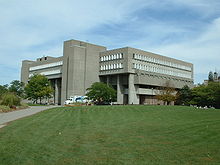
The brutalist Math and Computer Science building, as seen from what was then the B2 Green.

The Student Life Centre courtyard.
The main campus is located along University Avenue in Waterloo, Ontario on what was, until the 1960s, farmland. Since its creation, a considerable level of commercial and residential development has built up around the Waterloo campus, notably with many offices of high-tech firms. This has resulted in a major urban expansion into the surrounding rural areas, with a consequent loss of prime farmland and degradation of natural areas.
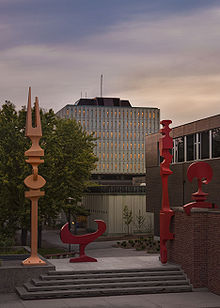
The Dana Porter Arts Library, with sculptures by Ron Baird in the foreground
Over a period of five years (2003–2008), the University experienced its second largest building boom since the 1960s. New buildings completed include the Tatham Building (Co-op Education), the Environmental and Information Technologies Building (chiefly Earth Sciences and Electrical Engineering), expansions to Burt Matthews Hall (Applied Health Sciences) and J.G. Hagey Hall, a building for the School of Architecture, a new Solar Technologies Building, a major addition to the School of Optometry Building, and sundry additions to several Engineering buildings. Currently (2010) under construction are the Quantum Nanotechnology Building, the Engineering 5 Building, the Engineering 6 Building, the Math 3 building, and the Environment 3 building.
To commemorate individuals who have made major contributions to the University of Waterloo, some buildings, most notably in the Engineering realm, have been renamed. Three examples include Engineering 4 becoming Carl Pollock Hall, Engineering Lecture Hall becoming Rod Coutts Hall, and the aforementioned Engineering 1 becoming the Douglas Wright Engineering Building. Some buildings, such as the Davis Centre (William G. Davis Computer Research Centre), the J.G. Hagey Hall of the Humanities, and Ira G. Needles Hall (Administration) were named after people at their time of inception.
The geographical coordinates of the main UW campus, using the NAD 83 datum, are 43°28′14″N 80°32′50″W / 43.47056°N 80.54722°W / 43.47056; -80.54722.
The School of Architecture was relocated to a former mill in Cambridge, Ontario, in 2004.
A new campus for the health sciences program has been built in Kitchener, Ontario and includes a satellite of McMaster University’s Michael G. DeGroote School of Medicine and the School of Pharmacy. The building opened in December 2008. The building has unique elements, such as a colourful curtain wall featuring images of medicinal plants and its use of natural materials such as wood.

South entrance to Main Campus. From left to right: Hagey Hall of the Humanities, Tatham Cooperative Education Centre, South Campus Hall.

A panoramic view of the campus from the BMH Green. From left to right: Davis Centre, Math & Computing, Student Life Centre, & Physical Activities Complex.
Faculties
- University of Waterloo Faculty of Applied Health Sciences
- University of Waterloo Faculty of Arts
- University of Waterloo Faculty of Engineering
- University of Waterloo Faculty of Environment
- University of Waterloo Faculty of Mathematics
- University of Waterloo Faculty of Science
Rankings and reputation
| University rankings |
| ARWU World |
201-302 |
| ARWU N. America |
100-134 |
| ARWU Engineering & CS |
51-77 |
| Newsweek World |
84 |
| THE-QS World |
113 |
| THE-QS Arts |
234 |
| THE-QS Life Sciences/Biomed |
114 |
| THE-QS Natural Sciences |
56 |
| THE-QS Social Sciences |
185 |
| THE-QS Engineering/Tech. |
27 |
| Canadian rankings |
| Maclean's Comprehensive |
3 |
|
v • d • e
|
More Canadian high-tech and knowledge-based spin-off companies trace their roots to the University of Waterloo than to any other school, and as such, the University of Waterloo and the Waterloo region has been called the "Silicon Valley of the North".
Great emphasis is placed on furthering the growth of research by quick and steady expansion of resources. The Institute for Quantum Computing, established in 2002, is one of a number of institutes and centres for research established, and has already begun to attract international scientists and a Nobel laureate to the university.
Computer Science and Mathematics
In the ACM International Collegiate Programming Contest, Waterloo students have won championships in 1994 and 1999. They have also won gold medals in 2000, 2001, 2002 and 2005.
Even though Waterloo was established in 1957, its teams have accumulated the sixth most top-five finishes in the Putnam competition ahead of Berkeley, Cornell, Stanford, Duke, Chicago, WUSL, Yale, Columbia and Carnegie Mellon among others.
Engineering
As one of the most competitive engineering schools in the country, and with students and alumni consistently placing in the top tier of international competitions such as ChallengeX, the University of Waterloo Faculty of Engineering is widely considered by industry and academics to be the foremost engineering school in Canada. With more than 6000 applicants annually, the school is one of the most selective in the country with mean averages of admitted students above 90 per cent in most programs. The school also holds the world record for the longest distance travelled by a solar car. Out of 24 participants in the 2008 North American Solar Car Challenge from the United States, Canada, United Kingdom and Germany, the University of Waterloo finished 4th overall and was the top Canadian team in the competition.
Students can choose to study in the following disciplines: Architecture, Chemical Engineering, Civil Engineering, Computer Engineering, Electrical Engineering, Environmental Engineering, Geological Engineering, Management Engineering, Management Sciences, Mechanical Engineering, Mechatronics Engineering, Nanotechnology Engineering, Software Engineering and Systems Design Engineering.
School of Accounting and Finance
The University of Waterloo School of Accounting and Finance offers undergraduate, masters, and doctoral programs. Its Masters of Accounting graduates are well prepared for the UFE exam for Chartered Accountants. The programs offered at the School of Accounting and Finance are Accounting and Financial Management (Public Accounting and Financial Management streams), Computing and Financial Management, Mathematics/Chartered Accountancy, and Biotechnology/Chartered Accountancy.
International rankings
According to the Times Higher Education World University Rankings 2009, the University of Waterloo was ranked 113th overall, 27th in the world for technology, 56th in the world for the natural sciences, and 114th in the world in life sciences and biomedicine.
According to the Academic Ranking of World Universities conducted by Shanghai Jiao Tong University, the University of Waterloo was ranked 201-302, 100-136 in North America, and 76-107 in Engineering Technology/Computer Science.
Globe and Mail Canadian University Report Card
In the annual Globe and Mail Canadian University Report Card, Waterloo was ranked first or tied for first amongst large universities in three categories. Waterloo received the highest grades for career preparation, quality of education, and academic reputation. Waterloo also ranked third in student satisfaction category and second on course availability/variety.
Maclean's rankings
Waterloo prides itself on its high performance in Maclean's magazine's Canadian university rankings. The university routinely places in the top three in the numerical Comprehensive ranking, and in the reputation survey it placed first as best overall 13 out of 15 times that the ranking was published. Maclean's describes the university as "strong in math, engineering and computer science," as well as being "internationally recognized for the unparalleled success of its more than 100 undergraduate and graduate co-op programs."
Co-operative education
Waterloo is famous for being a groundbreaking proponent of co-operative education in Canada and currently maintains the largest co-op program in the world with over 10,000 co-op students per year.
Ties with industry
Through its large co-op program (the largest in the world) and many spin-off companies, the University of Waterloo maintains close ties with the high-tech industry.
UW has a long-standing intellectual property policy that leaves ownership rights with the inventor, rather than the university, which has helped create many spin-off companies that maintain a good relationship with UW. In particular, it has a strong connection with Research In Motion, the makers of the Blackberry, that goes beyond its close physical proximity. Co-founder and CEO Mike Lazaridis was a UW student before he started RIM, and was the chancellor of the university. RIM hires hundreds of UW co-op students each term and a large proportion of its employees are UW alumni.
During his visit to Waterloo in October 2005, Microsoft co-founder Bill Gates stated, "Most years, we hire more students out of Waterloo than any university in the world, typically 50 or even more."
Agreement with Microsoft
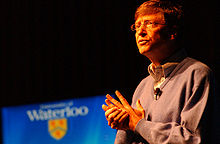
Bill Gates at the University of Waterloo
The university announced a controversial agreement with Microsoft in 2002. As part of this agreement, the University of Waterloo was to receive $2.3 million in funding from the Microsoft Canada Academic Innovation Alliance and would introduce Microsoft's C# programming language in its Electrical and Computer Engineering programs (also known as ECE.) The university came under harsh criticism for this agreement to develop Engineering courses using Microsoft's .NET Framework. The university administration asserted that this agreement would not jeopardize academic integrity at the institution, although the university president acknowledged making mistakes in announcing the deal.
The School of Computer Science was not part of this agreement, and currently offers Scheme and a choice of C or Python in its introductory courses.
Spin-offs
Several companies have roots in, or have been spun off from the university. (The large number of spin-offs from UW is in part due to the University's long-standing policy of allowing creators to retain all the rights to their inventions.) Some of the most notable spin-offs include:
- Certicom (acquired by Research In Motion) - founded by two Waterloo professors, Scott Vanstone and Gordon Agnew
- Intelligent Mechatronics Systems Inc. - founded by Waterloo professors, Otman Basir and Fakhreddine Karray
- Dalsa - founded by Waterloo electrical engineering professor Savvas Chamberlain
- Maplesoft - founded by two Waterloo professors, Keith Geddes and Gaston Gonnet
- Open Text Corporation - originated from the university's Oxford English Dictionary project
- SlipStream Data (acquired by Research In Motion) - founded by two Waterloo professors, En-hui Yang and Ajit Singh
- Watcom - founded by F.W. Crigger, K.I. McPhee and J.B. Schueler of the university's Computer Systems Group
- Northern Digital Inc. (NDI) - founded by Jerry Krist, also from the Computer Systems Group
- Volker-Craig - founded by M.C. Volker and R.G. Craig, Waterloo graduates in 1973
Notable companies founded by alumni
- Research in Motion
- QNX (acquired by Harman International, then acquired by Research in Motion from Harman)
- Quack.com (acquired by America Online)
- Sandvine (formerly PixStream, but in a different form when sold to Cisco)
- MKS Inc. (formerly known as Mortice Kern Systems)
- NexJ Systems (same alumni founded Janna Systems, which was acquired by Siebel Systems, which subsequently was acquired by Oracle Corporation)
- Digital Leisure
- Desire2Learn
- Teklogix (which was acquired by Psion in 2000, became Psion Teklogix)
Future plans
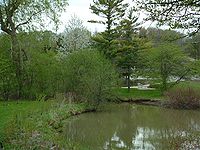
With a lake and a conservation area on campus, Waterloo is home to a variety of vegetation and wildlife.
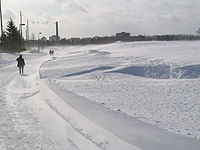
The fields just north of the University of Waterloo, before the development of the technology park.
The Faculty of Engineering, citing a shortage of space compared to the undergraduate and graduate enrollment and number of faculty members, is planning a $150M expansion between 2008 and 2012 in the form of three new buildings. Two are to be located outside Ring Road and linked back to the main campus by a walkway, while one will be built inside Ring Road in proximity to the current Engineering side of campus. The Iron Warrior reports that the Faculty has secured funding and received approval for the first of these three buildings, to be called Engineering 5, which will house a Student Design Centre showcasing the Waterloo Engineering student teams, along with space for the Department of Electrical and Computer Engineering, Department of Mechanical and Mechatronics Engineering, and the Department of Systems Design Engineering. The latter's original hopes for an exclusive building just for Systems are now dead according to Dean of Engineering Adel Sedra, as they were not able to locate the sufficient funds.
The university and the City of Kitchener are constructing a health sciences campus, including a School of Pharmacy, in the central Kitchener warehouse district. The project will cost $34 million for the first phase. The Honours co-operative Bachelor of Science in Pharmacy program began in January 2008. Preliminary operations, including staffed medical and optometry clinics, are based out of the former Victoria Public School in Kitchener's downtown.
The Kitchener site will also host a satellite campus of McMaster University's medical school, bringing 21 first-year medical students to Waterloo Region each year to study. They will remain until the end of the three-year McMaster program, and have the option of continuing as a resident in the area.
On October 16, 2006, President Johnston announced that the university has entered discussions with the City of Stratford and the Stratford Festival of Canada exploring the possibility of establishing a satellite campus in Stratford. On the same day, Stratford City Council unanimously endorsed a memorandum of understanding to continue exploration of the issue. This was clarified further on March 26, 2008, following a funding commitment in the previous day's provincial budget; the campus is to specialize in digital media and global business, and also has a funding commitment from Open Text corp.
With donations by alumni and matching contributions from government, the university announced in April 2004 the founding of the Institute for Quantum Computing.
Construction began in September 2008 for the Quantum-Nano Centre, a massive building which will house the Institute for Quantum Computing as well as the new Waterloo Institute for Nanotechnology. The building will be located in the centre of campus and its cost will exceed $100M. It is planned to be opened in September 2010.
Though in preliminary discussion there also has been talks for the initiation of a law program.
The university is currently planning for its sixth decade (2007–2017) with an "ambitious plan". According to the plan's documentation, some objectives are benchmarked by the following targets:
- By 2017, at least 12 UW academic programs will be the best in North America
- By 2017, at least 12 out of 44 departments/schools will be ranked top 12 in North America
- By 2017, at least 20 UW departments/schools will be ranked top three in Canada
- Each department/school will participate in a doctoral program
- All departments/schools will be ranked top 25% in Canada
UW has opened, in partnership with the Higher Colleges of Technology, a satellite campus in Dubai; the UAE Dubai Men's College campus. During earlier media releases of the Dubai plans, the campus had come under scrutiny for its perceived lack of transparency in the planning stages, as well as issues regarding the labour used, as well as UAE laws restricting the conventional Canadian freedoms of female and homosexual members of staff. In particular, debate has come up in both the student Senate, the university's Board of Governors over possible violations of policy 33, prohibiting discrimination based on sexual orientation.
Supported by the recent Knowledge Infrastructure Program, funded by the government, University of Waterloo have broken ground for three new buildings: Engineering 6 (sited right next to the current constructing Engineering 5), Mathematics 3 (sited at the green in between Photovoltaic Research Centre and the Davis Centre bridge) and Environment 3 (sited both next to and on top of Environment 2). All three buildings are scheduled for completion at March 2011.
Rebranding Controversy

The old logo (left) versus proposed new logo (right)
In late July 2009, news of a possible remodeling of the university logo surfaced. With a Facebook group reporting over 4000 members just three days after its creation and an article released in the National Post, the new logo has gathered somewhat large student and media attention. The key points offered by those opposing the new logo are that it lacks professionalism, does not portray Waterloo as the academic institution it claims to be, as well as the lack of student consultation in designing the new logo. Those for the new logo believe that it offers a look into the future of the University of Waterloo, capturing its ingenuity and ability to remain ahead of the times.

The three new logos being considered (right)
In the light of the rebranding controversy, the University of Waterloo administration has released several other designs and opened the floor to community feedback. After considering the feedback, Waterloo's new visual identity will not incorporate a new logo. Instead, the wordmark will be used on marketing materials, and the traditional seal used where a link to tradition is required.
Mascots
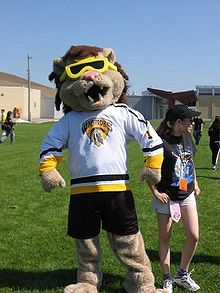
King Warrior, the athletics mascot
- The University's athletics mascot is a lion named King Warrior. The Warriors are the University's sports team and King Warrior's initials, K-W, reflect a common nickname for the cities of Kitchener and Waterloo.
- The mascot for the undergraduate students' Mathematics Society (MathSoc) is the Natural Log (see natural log), which is a wooden log about 60 cm (two ft) long, often mistaken as the Faculty's mascot.
- The mascot for the Faculty of Mathematics is a 12.2 m (40 ft) long and 3.4 m (11 ft) wide pink tie, often mistaken as MathSoc's mascot.
- The mascot for the Engineering Society is a 60" (1.5 m) pipe wrench called The TOOL, often mistaken as the Faculty's mascot. It was formerly the RIDGID Tool, because it was donated by the Ridge Tool Company in 1968. This mascot was stolen by University of Toronto Engineering students in 1982 and returned encased in a 45 gallon drum of concrete. Engineering students worked tirelessly for 6 hours using sledgehammers to free it.
- The mascot for the Faculty of Arts is a statue of a boar which was donated to the University of Waterloo Math Faculty in 1978, and in turn donated to the Arts Faculty. It is one of several copies of Italian sculptor Pietro Tacca's (1577–1640) "Il Porcellino" statue. Some students claim that rubbing the Boar's nose brings luck.
- The mascot for the Faculty of Environmental Studies is The Big Banana.
- The mascot for the Faculty of Applied Health Sciences is a Kangaroo.
- The mascot for the Science Society (SciSoc) is Arriba the Amoeba, a giant human-sized amoeba dressed in a lab coat.
- There is also a pair of 14 ft goggles which the Faculty of Science will be introducing for orientation week 2009, and potentially there will be an ongoing theme of goggles as science's mascot. Long term storage for the massive goggles has not yet been decided.
- Arts Students also find solidarity through a recognizable pair of sunglasses that all first-year students to the Faculty receive.
Fight song
Notable among a number of songs commonly played and sung at various events such as commencement, convocation, and athletic games are: University of Waterloo Seagrams! Seagrams! Vat 69. Warriors, Warriors, Hold that Line! and 'The Black and White and Gold,' with words by K.D. Fryer and H.F. Davis and music by Alfred Kunz.
Coat of arms
The coat of arms of the University of Waterloo was granted in 1987. The shield's blazon is as follows :
Or, on a chevron Sable between three lions rampant Gules a chevronel Argent.
The full blazon of the arms (rarely used) continues:
Above the Shield is placed a Helm suitable to an Incorporation (a Salade proper lined Gules) with a Mantling Sable doubled Or, and on a Wreath of the Liveries is set for Crest between two maple branches in saltire a trillium displayed and leaved all Proper, and in an Escrol over the same this Motto "CONCORDIA CUM VERITATE".
Representing Waterloo's location in the twin cities of Kitchener-Waterloo, the double-chevron is taken from the coat of arms of Earl Kitchener, and the red lions are taken from the symbol of Arthur, Duke of Wellington, the victor at the Battle of Waterloo.
Administration
Main article: University of Waterloo administration
更多
- Canadian government scientific research organizations
- Canadian industrial research and development organizations
- Canadian university scientific research organizations
- Centre for Applied Cryptographic Research
- Centre for Education in Mathematics and Computing
- Elliott Avedon Museum and Archive of Games
- Group of Thirteen (Canadian universities)
- List of colleges and universities named after people
- List of Ontario Universities
- List of University of Waterloo people
- Ontario Student Assistance Program
- University of Waterloo Computer Science Club
- University of Waterloo Federation of 学生
- Waterloo Co-operative Residence Incorporated
- Waterloo Warriors
Histories of the university
- James Scott 'Of Mud and Dreams: University of Waterloo 1957-1967' (Toronto: The Ryerson Press, 1967)
- Paul Axelrod 'Scholars and Dollars: Politics, Economics, and the Universities of Ontario 1945-1980' (Toronto: University of Toronto Press, September 1, 1982)
- Professor Brian McKillop, 'Matters of Mind: The University in Ontario, 1791-1951' (Ottawa: University of Ottawa Press © 1951)
- Dr. Kenneth McLaughlin 'Enthusiasm for the Truth: An Illustrated History of Saint Jerome's University', (Waterloo: University of Waterloo Press © 2002)
- Dr. Kenneth McLaughlin 'Waterloo: The Unconventional Founding of an Unconventional University' (Waterloo: University of Waterloo Press © 1997)
- Dr. Kenneth McLaughlin 'Out of the Shadow of Orthodoxy: Waterloo @ 50' (Waterloo: University of Waterloo Press © 2007)
- Flora Roy 'Recollections of Waterloo Lutheran University 1960-1973' (Waterloo: Wilfrid Laurier University Press, September 25, 2006)
参考文献
- ^ "Report on Giving". Office of Development. http://giving.uwaterloo.ca/recognition/2008/stats.html. Retrieved 2009-03-12.
- ^ About UW | University of Waterloo
- ^ "About UW". http://www.uwaterloo.ca/aboutuw/index.php. Retrieved 2007-08-14.
- ^ "A Brief History of the Faculty of Mathematics". University of Waterloo. http://www.math.uwaterloo.ca/navigation/About/history.shtml. Retrieved 2008-02-27.
- ^ "50th Anniversary". University of Waterloo. 2006-05-01. http://communications.uwaterloo.ca/documents/positioningstatement2006.doc. Retrieved 2008-04-14.
- ^ "Tech, health link proposed". Canada's Technology Triangle. http://www.techtriangle.com/viewnews.cfm?newsid=462. Retrieved 2008-03-04.
- ^ "About UW". http://www.uwaterloo.ca/aboutuw/index.php. Retrieved 2009-12-29.
- ^ "Imprint". University Of Waterloo. http://imprint.uwaterloo.ca. Retrieved 2009-04-08.
- ^ "The Iron Warrior". Engineering Society. http://iwarrior.uwaterloo.ca/. Retrieved 2009-04-08.
- ^ "MathNews". Math Society. http://www.mathnews.uwaterloo.ca/. Retrieved 2009-04-08.
- ^ The Canadian Encyclopedia
- ^ "How the Offer of 180 acres (0.73 km) of Farmland Changed the Identity of UW". The Iron Warrior. 2007. http://iwarrior.uwaterloo.ca/?module=displaystory&story_id=3043&format=html&edition_id=79. Retrieved 2007-09-07.
- ^ "$150M Engineering Expansion to Begin Next Year". The Iron Warrior. 2007. http://iwarrior.uwaterloo.ca/?module=displaystory&story_id=2999&format=html&edition_id=78. Retrieved 2007-08-07.
- ^ University
- ^ Wilfrid Laurier University
- ^ "Academic Ranking of World Universities". Institute of Higher Education, Shanghai Jiao Tong University. 2008. http://www.arwu.org/rank2008/EN2008.htm. Retrieved 2009-01-04.
- ^ "Top 100 North & Latin American Universities". Institute of Higher Education, Shanghai Jiao Tong University. 2008. http://www.arwu.org/rank2008/ARWU2008_TopAmer(EN).htm. Retrieved 2009-01-04.
- ^ "Top 100 world universities in Engineering/Technology and Computer Sciences". Institute of Higher Education, Shanghai Jiao Tong University. 2008. http://ed.sjtu.edu.cn/ARWU-FIELD2008/ENG2008.htm. Retrieved 2008-02-19.
- ^ "Top 100 Global Universities". Newsweek International. 2006. http://www.msnbc.msn.com/id/14321230/print/1/displaymode/1098/. Retrieved 2009-02-25.
- ^ "World University Rankings". Times Higher Education-Quacquarelli Symonds. 2008. http://www.timeshighereducation.co.uk/hybrid.asp?typeCode=243&pubCode=1&navcode=137. Retrieved 2008-12-31.
- ^ "THE-QS Top Universities Rankings: Arts and Humanities". Times Higher Education-Quacquarelli Symonds. 2008. http://www.topuniversities.com/worlduniversityrankings/results/2008/subject_rankings/arts_humanities/. Retrieved 2008-02-25.
- ^ "THE-QS Top Universities Rankings: Life Sciences and Biomedicine". Times Higher Education-Quacquarelli Symonds. 2008. http://www.topuniversities.com/worlduniversityrankings/results/2008/subject_rankings/life_sciences_biomedicine/. Retrieved 2008-02-25.
- ^ "THE-QS Top Universities Rankings: Natural Sciences". Times Higher Education-Quacquarelli Symonds. 2008. http://www.topuniversities.com/worlduniversityrankings/results/2008/subject_rankings/natural_sciences/. Retrieved 2008-02-25.
- ^ "THE-QS Top Universities Rankings: Social Sciences". Times Higher Education-Quacquarelli Symonds. 2008. http://www.topuniversities.com/worlduniversityrankings/results/2008/subject_rankings/social_sciences/. Retrieved 2008-02-25.
- ^ "THE-QS Top Universities Rankings: Technology". Times Higher Education-Quacquarelli Symonds. 2008. http://www.topuniversities.com/worlduniversityrankings/results/2008/subject_rankings/technology/. Retrieved 2008-02-25.
- ^ "Comprehensive Ranking". Maclean's. 2008. http://oncampus.macleans.ca/education/wp-content/uploads/2008/11/comprehensiveflat.pdf. Retrieved 2009-01-04.
- ^ "Seizing Opportunities". University of Waterloo. 2007. http://www.sixthdecade.uwaterloo.ca. Retrieved 2007-02-25.
- ^ "1994 ACM Past Contests". http://icpc.baylor.edu/Past/Default.htm. Retrieved 2010-03-05.
- ^ "1999 ACM Past Contests". http://icpc.baylor.edu/Past/Default.htm. Retrieved 2010-03-05.
- ^ "2000 ACM ICPC World Finals". http://icpc.baylor.edu/past/icpc2000/Finals/Standings.html. Retrieved 2007-07-19.
- ^ "2001 ACM ICPC World Finals". http://icpc.baylor.edu/past/icpc2001/Finals/Standings.html. Retrieved 2007-07-19.
- ^ "2002 ACM ICPC World Finals". http://icpc.baylor.edu/past/icpc2002/Finals/Standings.html. Retrieved 2007-07-19.
- ^ "2005 ACM ICPC World Finals". http://icpc.baylor.edu/past/icpc2005/Finals/Standings.html. Retrieved 2007-07-19.
- ^ "William Lowell Putnam Mathematical Competition". http://en.wikipedia.org/wiki/William_Lowell_Putnam_Mathematical_Competition#Teams_ranked_by_historical_performance. Retrieved 2010-03-05.
- ^ Vision 2010 Progress Report
- ^ American Solar Challenge - Home Page
- ^ Prospective Students - Engineering Undergraduate Programs | Faculty of Engineering | University of Waterloo
- ^ "Academic Rankings of World Universities by Broad Subject Fields - 2007". Institute of Higher Education, Shanghai Jiao Tong University. 2007-01-31. http://ed.sjtu.edu.cn/ARWU-FIELD.htm. Retrieved 2007-11-20.
- ^ "Canadian University Report 2010". http://static.globecampus.ca/uploads/docs/CUR2010_ChartsOnly.pdf. Retrieved 2009-10-25.
- ^ "2005 Overall Rankings Chart: Comprehensive ranking". Maclean's Magazine. 2005. http://www.macleans.ca/education/universities/article.jsp?content=20051104_162441_5048. Retrieved 2006-04-10.
- ^ "UW's historical rankings in Maclean's magazine". University of Waterloo Communications and Public Affairs. 2004. http://communications.uwaterloo.ca/macleans.html. Retrieved 2006-04-10.
- ^ Danylo Hawaleshka (2005). "Comprehensive winner: University of Waterloo". Maclean's Magazine. http://www.macleans.ca/education/universities/article.jsp?content=20051114_115664_115664. Retrieved 2006-04-10.
- ^ "Policy 73 – Intellectual Property Rights". University of Waterloo Secretariat. 1997. http://www.adm.uwaterloo.ca/infosec/Policies/policy73.htm. Retrieved 2006-04-10.
- ^ "Bill Gates draws a crowd at Waterloo university". CTV.ca. 2005. http://www.ctv.ca/servlet/ArticleNews/story/CTVNews/20051013/billgates_waterloo_20051013/20051013?hub=Canada. Retrieved 2006-04-10.
- ^ "More about the Microsoft alliance". University of Waterloo. 2002. http://www.bulletin.uwaterloo.ca/2002/aug/16fr.html. Retrieved 2007-07-09.
- ^ "Memorandum of Understanding between the University of Waterloo and Microsoft Canada". University of Waterloo. 2002. http://www.uwaterloo.ca/documents/microsoft/mou.html.
- ^ "Johnston acknowledges 'mistakes' in announcement of Microsoft deal". UW Gazette. 2002. http://www.information.uwaterloo.ca/Gazette/2002/sep18/microsoft.html. Retrieved 2007-07-09.
- ^ "CS 135: For Prospective Students". http://www.student.cs.uwaterloo.ca/~cs135/prospective.shtml.
- ^ "Cheering a future for UW in Stratford". UW Daily Bulletin. 27 March 2008. http://www.bulletin.uwaterloo.ca/2008/mar/27th.html. Retrieved 2009-04-08.
- ^ "UW welcomes federal investments in research and innovation". University of Waterloo. 2006. http://newsrelease.uwaterloo.ca/news.php?id=4665. Retrieved 2006-04-10.
- ^ "UW welcomes provincial government's investments in research and innovation". University of Waterloo. 2006. http://newsrelease.uwaterloo.ca/news.php?id=4707. Retrieved 2006-04-10.
- ^ "Completion of Quantum-Nano Centre Set for September 2010". The Iron Warrior. 2007. http://iwarrior.uwaterloo.ca/?module=displaystory&story_id=3041&format=html&edition_id=79. Retrieved 2007-08-07.
- ^ "'There have been talks' about law school". University of Waterloo. http://www.bulletin.uwaterloo.ca/2008/jan/14mo.html. Retrieved 2008-02-27.
- ^ "Pursuing Global Excellence: Seizing for Canada University of Waterloo (UW) Sixth Decade Plan". http://www.adm.uwaterloo.ca/infosec/Sixth_Decade_Plan.pdf. Retrieved 2006-12-02.
- ^ "There Will be Controversies". Imprint. 31 October 2008. http://imprint.uwaterloo.ca/index.php?option=com_content&task=view&id=3054&Itemid=55&issuedate=2008-10-31. Retrieved 2009-04-08.
- ^ "The Dubai Question". Imprint. 7 November 2008. http://imprint.uwaterloo.ca/index.php?option=com_content&task=view&id=3102&Itemid=58&issuedate=2008-11-07. Retrieved 2009-04-08.
- ^ "We're Going In". Imprint. 21 November 2008. http://imprint.uwaterloo.ca/index.php?option=com_content&task=view&id=3180&issuedate=2008-11-21. Retrieved 2009-04-08.
- ^ "UW-UAE Dubai campus is launched". UW Daily Bulletin. 27 February 2009. http://www.bulletin.uwaterloo.ca/2009/feb/27fr.html. Retrieved 2009-04-08.
- ^ "'Funded: math/eng and environment". http://www.bulletin.uwaterloo.ca/2009/jun/01mo.html. Retrieved 2009-11-11.
- ^ Nationalpost.com
- ^ University of Waterloo
- ^ University of Waterloo Daily Bulletin
- ^ "Canada Day Schedule (Right Side)". UW News Release. 26 June 2004. http://newsrelease.uwaterloo.ca/news.php?id=4120. Retrieved 2009-04-08.
- ^ "Goodbye to another Waterloo tradition, hello to a week off". Imprint. 16 February 2007. http://imprint.uwaterloo.ca/index.php?option=com_content&task=view&id=1028&Itemid=87. Retrieved 2009-04-08.
- ^ "The Tool: 40 Years Old and Still Ridgid". Iron Warrior. 27 June 2007. http://iwarrior.uwaterloo.ca/?module=displaystory&story_id=2979&format=html&edition_id=78. Retrieved 2009-04-08.
- ^ "Wrenching 40". Imprint. 19 October 2007. http://imprint.uwaterloo.ca/index.php?option=com_content&task=view&id=1822. Retrieved 2009-04-08.
- ^ During Orientation Week Porcellino is guarded by a group of Orientation Leaders known as "the Boar Tribe". Boar Tribe is present 24-7 during the week to protect the Boar against any potential attacks or vandalism.Celebrating the Boar | Display | Library | University of Waterloo
- ^ http://www.thecanadianencyclopedia.com/index.cfm?PgNm=TCE&Params=U1ARTU0000759SUBReadings Fight Songs
- ^ ece.uwaterloo.ca - ECE Undergrad Studies, section Coat of Arms
External links
- University of Waterloo
- Ontario Plaque—University of Waterloo
- Association of Universities and Colleges of Canada profile
 |
Wikimedia Commons has media related to: University of Waterloo |



